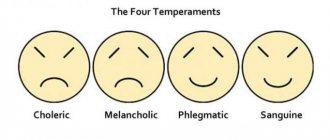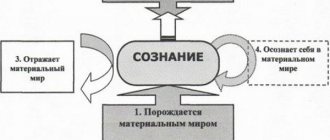Reactivity is one of the main properties of temperament. A person’s behavior in various situations depends on this quality. How do you make decisions: spontaneously, based on emotions, or after careful consideration? The answer to this question will show how developed your reactivity is and whether you can cope with unforeseen situations.
Temperament as perceived by philosophers and scientists of antiquity
Even ancient philosophers argued that a person has a number of characteristics given to him at birth, which are subsequently formed into a set of traits or so-called character. It is impossible to significantly change these features; they can only be easily adjusted under the influence of society and education.
Scientists of that time could not imagine what temperament or character depended on, but they made attempts to substantiate their numerous theories in proportion to knowledge in medicine and psychology. The founder of the typology of temperaments was Hippocrates; he was the first to define each of the types that are still used today. But the famous doctor explained temperament by the predominance of one or another liquid in the human body.
Years later, European scientists tried to put forward their own typology based on the physical characteristics of people. This version was subject to much criticism in the scientific world and is now practically not used.
How does temperament differ from character?
Let us remember that these are two completely different concepts. Character is formed, consolidated or changed under the influence of the following factors:
- education depending on the family situation;
- systematic independent work on oneself (self-education, self-development);
- the degree of acceptance of certain norms provided by the environment;
- analysis of acquired life experience.
In order to change even slightly in character, it is not enough to meet one of the listed conditions: their combination is required.
It is impossible to radically influence temperament as a property of human nature given from birth. However, using the same conditions given above, you can take control of it. The main criterion will be the desire of the person himself, patience and perseverance: the necessary changes will not happen in one hour, a systematic approach is important here.
Temperament through the eyes of Hippocrates and Claudius Galen
Hippocrates defined personality temperaments, and his student and follower Claudius Galen wrote a large scientific treatise, where he described each type in detail and detail, specifying the liquid that is contained in the maximum quantity in human organs.
Based on Galen's theory, there were the following types of human temperament:
- sanguine - this person had a large amount of blood, which influenced his actions and emotions;
- phlegmatic - he was the result of the predominance of phlegm;
- choleric - had increased bile content;
- melancholic - suffered from an abundance of black bile in the body, corroding his internal organs.
Almost until the eighteenth century, this theory was perceived as the only correct one. And only the hard work of modern scientists dispelled the fantastic assumptions of Hippocrates, although the names and characteristics of temperaments have remained unchanged and are actively used.
The power of education, childhood trauma
Various psychological traumas received in childhood undoubtedly influence the formation of personality, but this mostly relates to the character of the individual. Temperament can help to withstand pressure, injustice, misunderstandings and other situations that often occur at the instigation of parents, relatives or teachers. A different type of temperament, on the contrary, forces you to cave in, resign yourself, or fall into deep depression and hatred of the world.
Division into temperaments in modern psychology
Academician Pavlov made a great contribution to the development of psychology. As a result of research, he found out that a person from birth has his own type of nervous system, which determines his behavior. Moreover, this theory is equally effective for animals and people. Subsequently, Pavlov’s research became the basis for the work of Soviet and European psychologists. As a result, a scientifically based typology of human temperaments emerged:
- Sanguine. People of this temperament easily adapt to new conditions, are active and efficient. Most of them are friendly and have high communication skills. They are sensitive to the mood of others and are extroverts.
- Choleric. This temperament characterizes irritable and hot-tempered people. They get distracted from their work very quickly and find it difficult to concentrate. The expression of emotions in choleric people is violent and short-lived; they can also be considered extroverts.
- Phlegmatic person. Such people are very efficient, but it is difficult to switch from one thing to another. They are little emotional and are able to remain calm in any situation. All their movements are slightly slowed down, the same goes for facial expressions. Phlegmatic people are classified as introverts.
- Melancholic. Melancholic people are very sensitive, but not too active. They are touchy, but timid and inhibited. Such people have low productivity and have difficulty meeting new people. The slightest trouble causes violent emotions in them, paralyzing any activity.
To determine a person's temperament, it is necessary to consider him in relation to a number of properties. Psychology has a productive system that allows you to analyze the type of nervous system and classify it.
Definition of temperament and brief instructions for interaction
Groups that include people with different types of temperament work most effectively.
With a choleric person
The choleric type is characterized by impulsiveness, impetuosity and speed of movements, high excitability, harshness in communication, irritability, a tendency to emotional outbursts, and mood swings.
Possible rudeness, hot temper, affectation, inability to control oneself, touchiness. High efficiency is combined with a rapid loss of interest and the inability to complete a task if the process is delayed. Choleric people can be aggressive and often have difficulty communicating. At the same time, choleric people are optimists, they are full of energy, proactive, charismatic, and quickly forgive insults.
Colleagues should not react to the emotional outbursts of a choleric person or enter into an argument with him. A friendly, confident tone, interest in the conversation, and light, harmless humor will help him calm down.
With a sanguine person
Sanguine people are open, lively, friendly, cheerful, inquisitive, sociable people who easily experience failures. They have a flexible mind. They are resourceful, easily absorb information if desired, strive for new experiences and do not tolerate monotonous work well, and easily cope with organizational tasks.
Possible frivolity in work and study, reluctance to bring things to their logical conclusion, overestimation of one’s own capabilities, superficiality of judgment.
Sanguine people make good leaders at any level, capable of inspiring and organizing employees. To establish relationships, polite interest, praise, and recognition of his merits are enough.
With a melancholic person
Melancholic people are soft, tactful, sensitive and responsive, creative people, prone to reasoning. Under normal circumstances, they can be sociable, work well, be persistent and goal-oriented.
These are conscientious and responsible workers. They can be depressed, anxious, gloomy, secretive, and pessimistic. They do not tolerate stress well and do not like to make decisions.
Melancholic people are rarely interested in others. They easily obey, do not participate in competitions, and prefer to remain on the sidelines. You need to talk to a melancholic person calmly, without harsh words or intonations, and often praise.
Basic properties of temperament
Defining temperament is impossible without eight aspects that characterize it:
- sensitivity;
- activity;
- ratio of reactivity and activity;
- plasticity and rigidity;
- reaction rate;
- emotional excitability;
- extroversion or introversion.
An experienced psychologist assesses the personality for each aspect and determines the type of temperament. The most important parameters are considered to be reactivity and activity. It’s worth talking about them in more detail.
Structure, properties and types of temperament
The results of studies of the internal structure of temperament conducted by B.M. Teplov and V.D. Nebylitsyn, led to the conclusion that human temperament has three main, leading components [33, 54]:
- General mental activity is the intensity and volume of human interaction with the environment (physical and social). “The degrees of activity are distributed from lethargy, inertia and passive contemplation at one pole to the highest degrees of energy, powerful swiftness of action and constant ascent at the other” [33].
- Features of the motor sphere - the state of activity of the motor and speech motor apparatus. It is expressed in the speed, strength, sharpness, intensity of muscle movements and speech of a person, his external mobility (or, conversely, restraint), talkativeness (or silence). According to Nebylitsyn, the features of the motor sphere can be either considered separately or included in the composition of general mental activity.
- Emotionality is a complex of properties and qualities that characterize the emergence, course and cessation of various feelings, affects and moods. Expressed in emotional sensitivity (susceptibility and sensitivity to emotional influences), impulsiveness, emotional mobility or stability (speed of change of emotional states, their onset and cessation).
Each of the listed components, in turn, has its own complex structure and various forms of manifestation. All psychological components of the structure of temperament are called properties of temperament.
Studying the properties of temperament, V.S. Merlin identified the criteria for classifying certain psychological characteristics as properties of temperament: “we have the necessary grounds to classify as properties of temperament individual characteristics that:
- regulate the dynamics of mental activity as a whole;
- characterize the peculiarities of the dynamics of individual mental processes;
- have a stable and permanent nature and remain in development over a long period of time;
- are in a strictly natural relationship, characterizing the type of temperament;
- are uniquely determined by the general type of nervous system.
Using the listed characteristics, we can with sufficient certainty distinguish the properties of temperament from all other mental properties of the individual” [29].
Currently, according to the results of research by Teplov, Merlin, Rusalov and others, the following basic properties of temperament are distinguished [1, 3, 8, 22, 24, 27, 36, 49]:
- Sensitivity (sensitivity) is determined by the least force of external influences necessary for the occurrence of a person’s mental reaction, and the speed of occurrence of this reaction.
- Reactivity is the strength of involuntary emotional reactions to external or internal influences.
- Activity – indicates how intensely (energetically) a person influences the outside world and overcomes obstacles in achieving goals (perseverance, focus, concentration).
- The ratio of reactivity and activity determines what a person’s activity depends on to a greater extent: on random external or internal circumstances (moods, random events) or on goals, intentions, beliefs.
- Plasticity indicates how easily and flexibly a person adapts to external influences.
- Rigidity indicates how inert and rigid a person’s behavior is.
- Rate of reactions - characterizes the speed of various mental reactions and processes, rate of speech, dynamics of gestures, speed of mind.
- Extraversion, introversion - determines what a person’s reactions and activities primarily depend on - on external impressions arising at the moment (extrovert), or on images, ideas and thoughts associated with the past and future (introvert).
- Excitability of attention - the less the degree of novelty attracts attention, the more excitable it is for a given person.
- Inhibition is the speed of cessation of a particular cognitive process.
- Switchability is the speed of switching cognitive processes from one object to another.
- Emotional excitability is characterized by how weak an impact is necessary for the occurrence of an emotional reaction and at what speed it occurs.
- Emotional stability is the stability of an individual’s mood to external and internal influences.
- Impressiveness is the emotional sensitivity of an individual, his sensitivity to emotional influences, the ability to find ground for an emotional reaction where such ground does not exist for other people; the strength of influence of various stimuli on a person, the time they are stored in memory and the strength of the reaction to them.
- Emotionality is the speed and depth of a person’s emotional reaction to certain events.
- Impulsivity is the speed with which emotion becomes the motivating force of an action or action without first thinking it through and consciously deciding to carry it out; manifests itself in unrestrained reactions, in their spontaneity.
- Emotional lability is the speed with which a given emotional state ceases or one experience changes to another. How quickly and strongly a person “lights up” and how quickly he “fades away” depends on emotional lability.
- Resistance is resistance to unfavorable conditions, the ability to resist all internal and external conditions that weaken or inhibit the activity started.
It should be noted that the listed properties of temperament in most sources are side by side and not systematized.
Many researchers consider temperament and the criteria of its typology from the point of view of two or more properties of temperament. So, for example, J. Strelyau considers reactivity and activity to be the main fundamental dimensions of temperament, G. Eysenck – extraversion / introversion and emotional stability / instability (neuroticism) [50], S.L. Rubinstein bases the typology of temperaments on impressionability and impulsiveness [49], etc.
The most developed is the typology of temperament by I.P. Pavlova, described on the basis of the properties of temperament identified by his followers. An example of such characteristics of temperament types is given by V.D. Nebylitsyn [33]:
- The sanguine temperament is characterized by fairly high neuropsychic activity, variety and richness of facial expressions, emotionality, impressionability and lability. At the same time, the emotional experiences of a sanguine person, as a rule, are shallow, and his mobility under negative educational influences leads to a lack of proper concentration, haste, and sometimes superficiality.
- The choleric temperament is characterized by a high level of neuropsychic activity and energy of action, sharpness and swiftness of movements, as well as strength, impulsiveness and vivid expression of emotional experiences. Insufficient emotional and motor balance of a choleric person can result, in the absence of proper upbringing, in incontinence, hot temper, and inability to self-control under emotional circumstances.
- The temperament of a phlegmatic person is usually characterized by a relatively low level of behavioral activity and difficulty in switching, slowness and calmness of actions, facial expressions and speech, evenness, constancy and depth of feelings and moods. In case of unsuccessful educational influences, a phlegmatic person may develop such negative traits as lethargy, poverty and weakness of emotions, and a tendency to perform only habitual actions.
- Melancholic temperament is usually associated with such behavioral characteristics as a low level of neuropsychic activity, restraint and muted motor skills and speech, significant emotional reactivity, depth and stability of feelings with weak external expression. Due to these characteristics, with a lack of appropriate educational influences, a melancholic person may develop emotional vulnerability, increased to the point of painfulness, isolation and alienation, and a tendency to experience difficult internal experiences of life circumstances that do not deserve it at all.
At the same time, many researchers completely abandon the typology of temperament, believing that the number and variety of various types of temperament are too great: the classical classification, which includes four types of temperament, does not cover all possible options. In addition, in order to develop a final typology of temperament, it is necessary to completely complete the study of the properties of nervous processes, and to address this problem only based on final information about the biological foundations of temperament.
Thus, at the present stage of development of science, human temperament has not been sufficiently studied.
Next: General characteristics of emotions
Reactivity in psychology: definition
It is difficult to say when psychology became a serious science and began to consider a person’s personality taking into account all aspects of temperament. But the scientific community believes that Wolf Solomonovich Merlin was the first to introduce such a concept as reactivity in psychology. This gave impetus to further research into the psycho-emotional differences of individuals, which eventually resulted in a fundamental scientific theory.
At the moment, it can be argued that reactivity in psychology is the uncontrolled reactions of an individual to any stimuli of an external and internal nature. The intensity and duration of these reactions largely determine a person’s temperament. Subsequently, psychologists came to the conclusion that emotional reactivity is responsible for performance and productivity. In psychology, this has acquired particular importance; many large corporations in the West use the concept of reactivity when selecting new personnel.
The influence of temperament on human life
Temperament largely determines certain aspects of an individual's life. Eg:
- shaping his environment;
- quality of life, feeling of internal and external comfort;
- the ability to withstand difficulties and adapt to new conditions;
- achievements and losses;
- perception of what is happening;
- susceptibility to emotions when making important decisions or a cool-blooded analysis of possible consequences and much more.
Reactivity and speed of decision making: is there a relationship?
Based on the results of numerous studies and tests, psychologists have found that the speed of decision-making and reactions to various life situations depends on reactivity.
People with high reactivity often make decisions under the influence of emotions and the moment; many of their conclusions and reactions are incorrect. But in a critical situation, they can save the life of not only one person, but also many others. The same cannot be said about individuals with low reactivity. They think about every decision for a long time and are not able to make it at a specific moment under the influence of stimuli from the outside world.
Constitutional theory of Ernst Kretschmer
This typology was created by psychologist and psychiatrist Ernst Kretschmer based on the discovery of stable connections between a variety of temperament and an individual’s innate physique. In simple words, people with certain differences in the constitution of the body have corresponding features of the structure of the psyche.
A preliminary assessment of body structure often helps to establish contact from the first minutes of communication.
Asthenic type (schizothymic)
Absolutely weak-willed, withdrawn, focused on his inner world. Prone to sudden mood swings. On the one hand, he is an intelligent dreamer, on the other, he is a stubborn egoist and abstract dreamer.
Pyknic type (cyclothymic)
He is either at the very top of the emotional wave, or sharply goes to the bottom. Being cheerful, positive and very talkative, he easily gets used to any company, becoming an ideal interlocutor.
Athletic type (ixothymic)
It's hard to surprise him with anything. Calm, reserved, not generous with gestures and facial expressions. It costs him enormous effort to adapt to new conditions. Doesn't have flexible thinking.
Formula for Reaction Intensity in Emotional Reactivity
Since reactivity in psychology is a reaction to an external stimulus, it would be natural to assume that it has a certain strength. In the modern world, there is even a formula according to which you can determine the degree and intensity of the reaction.
In people with low reactivity, intensity is in direct interaction with the strength of the impact. The more pressure you put on such a person, the more intense his reaction.
Otherwise, everything happens to people who are easily excitable. The intensity of their reaction is absolutely independent of the strength of the impact. Even slight pressure triggers an intense reaction in the individual. This makes highly reactive people unpredictable and difficult to manage.
Main types of temperament
Today in psychology the system of temperaments developed by Academician Pavlov is used. He found out that each person has a special nervous system. She determines how he will behave. Interestingly, the theory applies to humans and animals.
So, according to Pavlov, the description of temperaments looks like this:
- Sanguines. They quickly find a common language with different people. They do not tolerate monotony. Change jobs easily. They speak loudly, actively gesticulating. Has an unstable emotional state. People with this type of temperament develop feelings quickly. But they pass just as quickly.
- Phlegmatic people. They are characterized by slowness, balance, slowness, and calmness. They do not express feelings, they communicate smoothly with others. They have a stable mood. Phlegmatic people cannot be enraged or emotionally hurt.
- Cholerics. They are known for their tendency to hasty speech, excessive mobility, bright facial expressions and gestures. The mood of representatives of this type of temperament changes instantly. They are unbalanced, unrestrained, and do not know how to objectively assess people and the situation around them.
- Melancholic people. They are characterized by a slow course of mental processes. They are passive, not interested in the life around them, withdrawn and often lonely. Feelings in such people develop slowly. However, they differ in depth.
It is noteworthy that in psychology there are no 100% sanguine people or, for example, choleric people. Usually the temperaments are mixed.
Interesting! “A melancholic person will take for a tragedy what a sanguine person will see only as an interesting incident, and a phlegmatic person will see as something not worthy of attention” - Arthur Schopenhauer.
Reactivity in psychology: examples of manifestation in everyday life
In order to have a complete understanding of reactivity, let's give a simple real-life example. Let's say you're dreaming of a vacation after a hard year of work. Your friends are also going to relax, but one goes to the mountains, and the other dreams of a lazy beach holiday in a warm country. Both of them invite you to come with them, but after much deliberation you decide to go on a trip to the sea and the sun. At that moment, when you are ready to voice your decision to a friend, he begins to argue that you must go with him and have no right to do otherwise. This is where your reactivity matters a lot. What will you do? Will you begin to resist the pressure and abandon your already planned and much-desired vacation on the beach, going to the mountains as a protest? Or stick to the original plan, no matter the pressure put on you?
People who are capable of doing harm to themselves are characterized by increased reactivity and often draw the wrong conclusions from the situation. Moreover, the opponent’s personality does not play a role in making a decision; it can be a close friend or a stranger. A tendency to make hasty and incorrect decisions is revealed in those people who have increased reactivity. In psychology, this is considered to be a constant, which is used as a starting point in determining a person’s temperament.
Definition of what it is
Reactivity in psychology is an unpleasant state that occurs in response to lack of freedom. Initially, the concept of temperament was considered by Hippocrates and his student C. Gallen. They said that there are some innate character traits and behavior of people that cannot be changed or adjusted.
Scientists have developed a theory based on the predominance of fluids in the body:
- sanguine people - blood;
- phlegmatic people – mucus;
- choleric people – yellow bile;
- melancholics – black bile.
These characteristics were considered unchanged until the 20th century, but with the development of science, the description of temperament types expanded.
I. Pavlov supplemented the teaching based on the characteristics of the nervous system:
- A sanguine person is a person with loud, emotional speech. Not afraid of change, characterized by a positive mood, not prone to despondency and sadness.
- Phlegmatic is a calm and balanced type. Does not express feelings and has a stable mood. They are difficult to provoke and are difficult to anger.
- Choleric is a hot-tempered, unrestrained person. Reacts sharply to stimuli, but moves away easily.
- Melancholic - mental processes in this type proceed slowly. These are passive, withdrawn people. Characterized by the depth of experience.
Despite the descriptions, there are no people who completely fit one of the types. Usually human behavior is based on the predominance of one of them. Further research into temperament showed that this phenomenon has its own characteristics.
Reactivity in psychology
| Property | Description |
| Reactivity | The basis of temperament, determines the reaction to external stimuli |
| Sensitivity | Sensitivity to external factors |
| Plasticity-rigidity | The ability of the psyche to adapt to changing conditions |
| Introversion-extroversion | Focusing attention on the internal or external world |
| Excitability | Emotional reaction to stimuli |
| Reaction rate | Reaction speed in response to external influences |
J.W. Brehm conducted a study in 1981 in which he discovered the manifestation of reactivity through showing children accessible and inaccessible objects. As a result, it turned out that children deeply experience the fact that they cannot get something.
In his work, P. Silvia wrote that when reactivity is shown, it is necessary to provide a message that will create the appearance of the proposed situation as threatening. This way you can reduce the negative effect of the event.
K. Miller and his colleagues in 2006 proposed the concept that reactivity influences adolescent behavior. Smoking and other addictions of this age arise as a response to the prohibitions and instructions of adults.
Reactivity and activity: features of the relationship
It has long been proven that the productivity of any human activity is determined by the ratio of reactivity and activity. In psychology, this was expressed in several formulas that emerged as a result of special and lengthy research. Highly reactive individuals have little activity, since they cannot work with concentration and are constantly distracted by the slightest external stimuli. In addition, this type is also affected by internal stimuli - thoughts, emotions, memories. All this significantly reduces labor productivity.
Individuals with low reactivity usually have the highest activity. They are able to solve one problem until a result is achieved, without being distracted by anything in the world around them. Such people are able to work for weeks and months until they get what they want. Scientists who have given the world great discoveries are often classified as this type.
The psychological reactions of many people cannot be controlled, but with certain knowledge, it is possible to predict a person’s behavior and draw conclusions about his capabilities on the way to the top of his career.
What did ancient scientists and philosophers think about temperament?
Philosophers and ancient scientists believed that at birth a person receives a set of qualities that determines his future life. It is not possible to completely change qualities. However, they are easy to correct using social influence or education.
First, Hippocrates, and after his student Claudius Gallen, identified and described 4 types of temperament. They differed from each other in the content of special substances in the body:
- Sanguine. There is a lot of blood in the body, the high content of which determines its actions.
- Phlegmatic person. This type of temperament is due to the presence of phlegm.
- Choleric. There is too much bile in the body of such people.
- Melancholic. Filled with black bile, which gradually eats from the inside.
Until the 18th century, this theory was considered the only correct one. In the 21st century, the names of temperament types have remained the same. But the description has changed.
What is temperament
Temperament is based on the type of higher nervous system. People (like animals) differ from each other from birth:
- by the strength of the processes of excitation and inhibition;
- the balance of these processes;
- mobility (changeability) of excitation and inhibition processes.
Taken together, this determines the endurance of nerve cells, that is, the endurance of the psyche.
Discovery of temperament
When excitation predominates over inhibition, conditioned reflexes are formed quickly and slowly subside, and when the ratio is reversed, conditioned reflexes are formed slowly and quickly fade away. These patterns were discovered by the domestic scientist Ivan Petrovich Pavlov.
This discovery made an invaluable contribution to the further development of psychology and pedagogy. Currently, there is no doubt that each person requires an individual approach in the process of upbringing, training or psychological correction.
Temperament and personality
Temperament is a set of innate mental properties. It serves as the basis for character formation. This is what is biological in a person.
At the same time, temperament is involved in the formation of personality. As a set of individual characteristics, it influences the dynamics and emotional side of human activity and behavior.
Depends on temperament:
- speed of occurrence of mental activity;
- stability of mental processes;
- mental tempo and rhythm;
- intensity of mental processes;
- direction of mental activity.
Anxiety, impulsiveness, emotionality, impressionability and other personality traits depend on temperament.
Temperament and character
Temperament is often confused with character. I propose to put an end to the differentiation of these issues once and for all.
- If character is a product of socialization, then temperament is an innate, unchangeable feature of an individual.
- You cannot change your temperament, but you can learn to manage it. Character can be changed.
- Temperamental traits can be masked by personality traits, making it difficult to determine what type of temperament a particular person belongs to.
Temperament and activity
Temperament provides an individual style of activity, that is, work methods characteristic of a particular person. So, for example, one child, when solving a problem, can sit idle for a long time, think about it and immediately write down the result, while another will immediately start writing something down, sketching it out, crossing it out, and after a while will isolate the main thing from it. Same result - different ways to achieve it.
How it manifests itself
Reactivity in psychology is a person’s reaction to actions or rules that limit freedom. The theory of property is based on the fact that every person can exercise freedom and act according to it. Expressing free behavior requires the psychological and physical ability to take responsibility for one's actions.
Reactivity manifests itself according to the following scheme:
- feeling of freedom;
- restriction of freedom;
- manifestation of resistance;
- restoration of freedom.
Freedom here is understood as an internal feeling of many options for behavior, actions, emotions, and relationships. Behavior is considered free if the individual fully exhibits it or expects its implementation in the future. Any situation that interferes with the exercise of freedom is a danger.
Free choice of when and how to behave and awareness of the degree of personal freedom influence the appearance of reactivity. A threatening situation is seen as a challenge, a signal to action. Fear of losing independence leads to attempts to regain it by overcoming obstacles and resisting external stimuli.
Reactivity has several characteristics:
- This property is used in manipulative actions, initially offering options that must be called “undesirable” for the subsequent selection of “desirables”.
- Reactivity changes the results of psychological experiments. This is called the Hawthorne effect. It means that when people are aware of surveillance, they stop behaving naturally.
- The greater the significance of the event, the stronger and more emotional the reaction.
- Also, if the significance of the situation is imposed from the outside, then the resistance will be stronger.
- Under any circumstances, a person will expect the restoration of freedom.
- Reactivity is used in reverse psychology to interfere with rational decision making.
- The property is characterized as emotional, not rational, as it arises at lightning speed, without thinking.
Sometimes situations arise that show the impossibility of exercising freedom and represent its deprivation. Reactivity as a property of temperament should manifest itself only initially. When realizing the hopelessness of the situation, the feeling of resistance subsides.
Some threatening events cause only minor difficulties, while others completely destroy the opportunity to exercise independence. Reactivity has the effect of restoring freedom that is in danger. But such attempts are weakened by opposing forces.
As the pressure to conform increases, resistance and motivation through the surrender of one's own will will increase. There will also be events where there is an opportunity to restore freedom, but the costs of implementing the effort are too high to weaken the opposition. Both of these forces reduce or make impossible the very attempts to restore independence.
In everyday life, reactivity is used in marketing. For example, sales are always relevant because the products on offer seem more needed in times of shortage. A similar principle works in raising children. When parents say that a child is too young to try a particular product, the child becomes excited about trying to get it.
In literature, the reactivity effect is well described by the story of Tom Sawyer, who convinced his friends that they really wanted to paint the fence instead of going to the river. The property is also shown in the play Romeo and Juliet. The ban on communication and social restrictions make a partner more desirable, as they act through a threat to the freedom of the main characters of the work.









